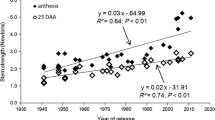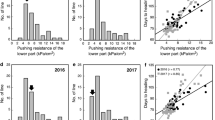Abstract
We demonstrated the new target for lodging resistance in rice (Oryza sativa L.) by the analysis of physiological function of a locus for lodging resistance in a typhoon (lrt5) with the near isogenic line under rice “Koshihikari” genetic background (tentatively named S1). The higher lodging resistance of S1 was observed during a typhoon in September 2004 (28 days after heading), when most other plants in “Koshihikari” became lodged. Visual observations showed that bending of the upper stems triggered lodging during the typhoon; the upper stem of “Koshihikari” buckled completely, whereas that of S1 remained straight. In addition to the strong rain and winds during the typhoon, the weight of the buckled upper plant parts increased the pressure on adjacent plants and caused a domino effect in “Koshihikari”. Young’s modulus, an indicator of the rigidity of the culm, was significantly higher in S1 than in “Koshihikari”. In the upper culm, the starch content in S1 was 4.8 times the value in “Koshihikari”, and senescence was delayed in the upper leaves of S1. These results suggest that the rigidity of the upper culm by the higher starch content (as a result of delayed senescence in the upper leaves) may be responsible for the higher lodging resistance during a typhoon in rice.





Similar content being viewed by others
Abbreviations
- NIL:
-
Near-isogenic line
- QTLs:
-
Quantitative trait loci
References
Brancheriau L, Baillères H, Sales C (2006) Acoustic response of xylophone bars: experimental and analytic approaches of frequency shift phenomenon during the tuning operation of xylophone bars. Wood Sci Tech 40:94–106
Cook JH, Yoshida S (1972) Accumulation of 14C-labelled carbohydrate before flowering and its subsequent redistribution and respiration in the rice plant. Proc Crop Sci Soc Jpn 41:226–234
Chonan N (1993) Stem. In: Matsuo T, Hoshikawa K (eds) Koshihikari. Science of the rice plant in rice. Nobunkyo, Tokyo, pp 187–221
Cilas C, Godin C, Bertrand B, Baillères H (2006) Genetic study on the physical properties of Coffea Arabica L. wood. Tree 20:587–592
Epstein EB (1999) Silicon. Annu Rev Plant Physiol Plant Mol Biol 50:641–664
Friedrich JW, Huffaker RC (1980) Photosynthesis, leaf resistances, and ribulose-1,5-bisphosphate carboxylase degradation in senescing barley leaves. Plant Physiol 65:1103–1107
Gentinetta E, Bertolini M, Rossi I, Lorenzoni C, Motto M (1990) Effect of brown midrib-3 mutant on forage quality and yield in maize. J Genet Breed 44:21–26
Hozyo Y, Oda K (1965) Studies on the stiffness of culms in barley plants (Hordeum sativum, Jessen). Proc Crop Sci Soc Jpn 34:163–170
Ishiguro K (1995) Breeding in rice cv. Koshihikari. Koshihikari. In: Oritani T (ed) Koshihikari. Nobunkyo, Tokyo, pp 628–637
Ishimaru K (2003) Identification of a locus increasing rice yield and physiological analysis of its function. Plant Physiol 133:1083–1090
Ishimaru K, Hirose T, Aoki N, Takahashi S, Ono K, Yamamoto S, Wu J, Saji S, Baba T, Ugaki M, Matsumoto T, Ohsugi R (2001a) Antisense expression of a rice sucrose transporter OsSUT1 in rice (Oryza sativa L.). Plant Cell Physiol 42:1181–1185
Ishimaru K, Yano M, Aoki N, Ono K, Hirose T, Lin SY, Monna L, Sasaki T, Ohsugi R (2001b) Towards the mapping of physiological and agronomic characters on a rice function map: QTL analysis and comparison between QTLs and expressed sequenced tags. Theor Appl Genet 102:793–800
Kashiwagi T, Ishimaru K (2004) Identification and functional analysis of a locus for improvement of lodging resistance in rice. Plant Physiol 134:676–683
Kashiwagi T, Sasaki H, Ishimaru K (2005) Factors responsible for decreasing sturdiness of the lower part in lodging of rice (Oryza sativa L.). Plant Prod Sci 8:166–172
Kawano M, Takahashi T (1961) Relationship between bendability and its ingredient. Jpn J Soil Sci Plant Nut 32:149–152
Keller M, Karutz CH, Schmid JE, Stamp P, Winzeler M, Keller B, Messmer MM (1999) Quantitative trait loci for lodging resistance in a segregating wheat x spelt population. Theor Appl Genet 98:1171–1182
Khush GS (1999) Green revolution: preparing for the 21st century. Genome 42:646–655
Koizumi A, Ueda K (1986) Estimation of the mechanical properties of standing trees by bending test 1-Test method to measure the stiffness of a tree trunk (in Japanese with English abstract). Mokuzai Gakkaishi 9:669–676
Kono M, Takahashi J (1961) Studies on the relationship between breaking strength and chemical components of paddy stem (in Japanese). J Sci Soil Manure Jpn 32:149–152
Lin HX, Liang ZW, Sasaki T, Yano M (2003) Fine mapping and characterization of quantitative trait loci Hd4 and Hd5 controlling heading date in rice. Breed Sci 53:51–59
Markwell J, Osterman JC, Mitchell JL (1995) Calibration of the Minolta SPAD-502 leaf chlorophyll meter. Photosynth Res 46:467–472
Marquard RD, Tipton JL (1987) Relationship between extractable chlorophyll and an in situ method to estimate leaf greenness. Hort Sci 22:1327
Miyasaka A, Takaya T (1982) Prevention of lodging of rice plants under direct sowing culture on well-drained paddy field. I. Varietal differences in lodging resistance under dense sowing (in Japanese with English abstract). Jpn J Crop Sci 51:360–368
Mulder EG (1954) Effect of mineral nutrition on lodging of cereals. Plant Soil 5:246–306
Nelson JC (1997) QGENE: software for marker-based genomics analysis and breeding. Mol Breed 3:239–245
Niklas KJ (1993) Influence of tissue density-specific mechanical properties on the scaling of plant height. Ann Bot 72:173–179
Ookawa T, Ishihara K (1992) Varietal difference of physical characteristics of the culm related to lodging resistance in paddy rice (in Japanese with English abstract). Jpn J Crop Sci 61:419–425
Ookawa T, Ishihara K (1993) Varietal difference of the cell wall components affecting the bending stress of the culm in relation to the lodging resistance in paddy rice (in Japanese with English abstract). Jpn J Crop Sci 62:378–384
Sato K (1957) Studies on the starch contained in the tissues of rice plant (in Japanese with English abstract). Proc Crop Sci Soc Jpn 26:19
Takaya T, Miyasaka A (1983) Prevention of lodging of rice plants under direct sowing culture on well-drained paddy filed (in Japanese with English abstract). Jpn J Crop Sci 52:7–14
Togawa E, Kondo T (1999) Change of morphological properties in drawing water-swollen cellulose films prepared from organic solutions. Tech J Polym Sci Part B: Polym Phys 37:451–459
Undersander DJ, Bauman LF, Lechtenberg VL, Zuber MS (1977) Effect of cyclic selection for high and low crushing strength on rind, pith and whole stalk composition in corn. Crop Sci 17:732–734
Yamamoto H (1995) Lodging and difference in cultivars. Koshihikari. In: Oritani T (ed) Koshihikari. Nobunkyo, Tokyo, pp 112–114
Yamamoto H, Suzuki Y, Hayakawa S, Kishida Y (1992) Rice crop damages in Kyushu caused by the typhoon of 9117 and 9119 (in Japanese). J Agric Metrol 48:175–180
Zhang JQ, Hayakawa S, Yamamoto H, Okada N, Tatano H (2002) Comparisons of agricultural damages by typhoon 9117, 9119 and 9918 (in Japanese with English abstract). Jpn J Crop Sci 71:239–249
Acknowledgments
We thank Dr. Masahiro Yano of NIAS for providing plant materials. This work was supported by the Program for Promotion of Basic Research Activities for Innovation Biosciences (PROBRAIN).
Author information
Authors and Affiliations
Corresponding author
Electronic supplementary material
Below is the link to the electronic supplementary material.
Rights and permissions
About this article
Cite this article
Ishimaru, K., Togawa, E., Ookawa, T. et al. New target for rice lodging resistance and its effect in a typhoon. Planta 227, 601–609 (2008). https://doi.org/10.1007/s00425-007-0642-8
Received:
Accepted:
Published:
Issue Date:
DOI: https://doi.org/10.1007/s00425-007-0642-8




